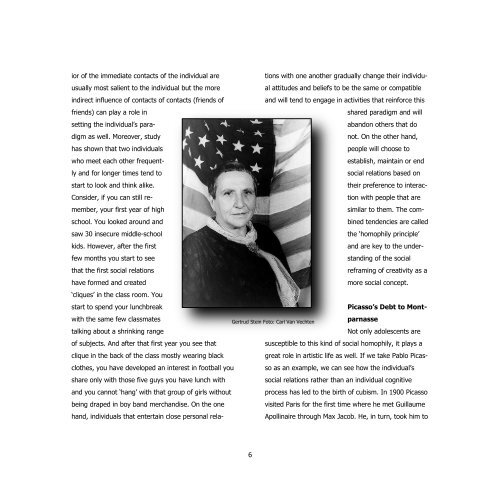Nr 15 Kreativitet: PDF-version - Populär Poesi
Nr 15 Kreativitet: PDF-version - Populär Poesi
Nr 15 Kreativitet: PDF-version - Populär Poesi
Create successful ePaper yourself
Turn your PDF publications into a flip-book with our unique Google optimized e-Paper software.
ior of the immediate contacts of the individual are<br />
usually most salient to the individual but the more<br />
indirect influence of contacts of contacts (friends of<br />
friends) can play a role in<br />
setting the individual’s para-<br />
digm as well. Moreover, study<br />
has shown that two individuals<br />
who meet each other frequent-<br />
ly and for longer times tend to<br />
start to look and think alike.<br />
Consider, if you can still re-<br />
member, your first year of high<br />
school. You looked around and<br />
saw 30 insecure middle-school<br />
kids. However, after the first<br />
few months you start to see<br />
that the first social relations<br />
have formed and created<br />
‘cliques’ in the class room. You<br />
start to spend your lunchbreak<br />
with the same few classmates<br />
talking about a shrinking range<br />
of subjects. And after that first year you see that<br />
clique in the back of the class mostly wearing black<br />
clothes, you have developed an interest in football you<br />
share only with those five guys you have lunch with<br />
and you cannot ‘hang’ with that group of girls without<br />
being draped in boy band merchandise. On the one<br />
hand, individuals that entertain close personal rela-<br />
6<br />
tions with one another gradually change their individu-<br />
al attitudes and beliefs to be the same or compatible<br />
and will tend to engage in activities that reinforce this<br />
Gertrud Stein Foto: Carl Van Vechten<br />
shared paradigm and will<br />
abandon others that do<br />
not. On the other hand,<br />
people will choose to<br />
establish, maintain or end<br />
social relations based on<br />
their preference to interac-<br />
tion with people that are<br />
similar to them. The com-<br />
bined tendencies are called<br />
the ‘homophily principle’<br />
and are key to the under-<br />
standing of the social<br />
reframing of creativity as a<br />
more social concept.<br />
Picasso’s Debt to Mont-<br />
parnasse<br />
Not only adolescents are<br />
susceptible to this kind of social homophily, it plays a<br />
great role in artistic life as well. If we take Pablo Picas-<br />
so as an example, we can see how the individual’s<br />
social relations rather than an individual cognitive<br />
process has led to the birth of cubism. In 1900 Picasso<br />
visited Paris for the first time where he met Guillaume<br />
Apollinaire through Max Jacob. He, in turn, took him to



